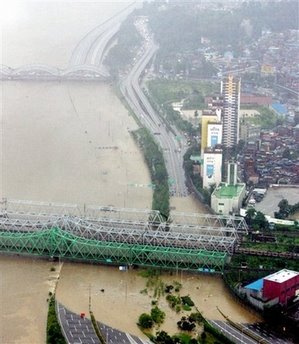 While we in South Korea are still recovering from days of torrential rain that have flooded major transportation arteries — particularly those built along waterways such as the Han River and the Chungnangch'ŏn Stream — it's important to note that North Koreans have also been hard hit.
While we in South Korea are still recovering from days of torrential rain that have flooded major transportation arteries — particularly those built along waterways such as the Han River and the Chungnangch'ŏn Stream — it's important to note that North Koreans have also been hard hit.The International Federation of Red Cross and Red Crescent Societies, one of the few international groups operating in the DPRK, is reporting that more than a hundred people are dead or missing in North Korea due to floods and landslides. The damage has cut off telephone connections, they said, making the collection of reliable information difficult.
By the way, the picture here, taken last Sunday, is of the Olympic Expressway, a key highway for east-west commuters. Many other roads were flooded and impassable, including the Tongbu Kansŏndoro (translated as Tongbu Expressway?), a major thoroughfare for people living in the northern parts of Seoul.
UPDATE:
North Korea is officially saying now that hundreds of people are dead or missing following heavy rains this month. They also said that tens of thousands of buildings, bridges, and roadways have been destroyed by floods or landslides.
And as in the past, there are indications that food production has been badly affected and there is a risk of famine, at a time when South Korea has cut off rice and fertilizer aid in protest of the July 5 missile launchings.
Geez, no wonder Koreans don't like the rain! They need it more evenly spread like us... ie everyday!
ReplyDelete"Tongbu Kansŏndoro" (東部幹線道路) would probably best be translated as "Eastern Trunk Road," but I have no idea if that's how it actually is translated.
ReplyDeleteWhen I drive over there again, I'll try to make a point of seeing how they do it. I think Tongbu/Dongbu Expressway is how it's written, but I think the Korean term is originally a direct translation of something like "Eastern Corridor." In Southern California, some of the newer freeways and tollways (yes, we have tollways in OC) are called transportation corridors.
ReplyDeleteThe 순환도로 is sometimes translated as Circle Road -- a literal translation -- but I have also seen it translated as Beltway, as in Washington DC's Beltway.
Seoul is probably laid out more like the DC area than most other places in America, so that would make sense.
Not to be pedantic (moi!?), but 순환도로 would be a "circulation road," but seeing as "circulate" is derived from "circle," "circle road" or "circular road" is apt.
ReplyDelete"Trunk road" is an oscure term, although there a couple of old 19th-century roads in the Vancouver area called "trunk roads" (not that they would have got the idea from us). 幹 (줄기 간) means "trunk [of a tree]." 간선 without the 도로 on the end would be a "trunk line."
Anyhow, you are correct: it is called the "Dongbu Expressway," according to this very useful resource:
http://englishname.seoul.go.kr/cSearch.php?page=160&cTypeSub=26&cType=3